Many parts of the IT business are based on structures. In a poorly functioning business, issues are categorized according to a fixed structure, responsibility is allocated according to another structure, finances are measured and documentation is sorted according to their structures. These structures are often developed specifically for each area, which results in there being no common structure for the IT operation as a whole.
Instead of creating different structures for different purposes, a single structure should be created as a base for all areas within the IT organization. This facilitates coordination between different areas such as responsibility and issue categorization. Directly categorizing all issues based on the same structure we have used to allocate responsibility makes it simple to produce reports. This common structure is called service structure.
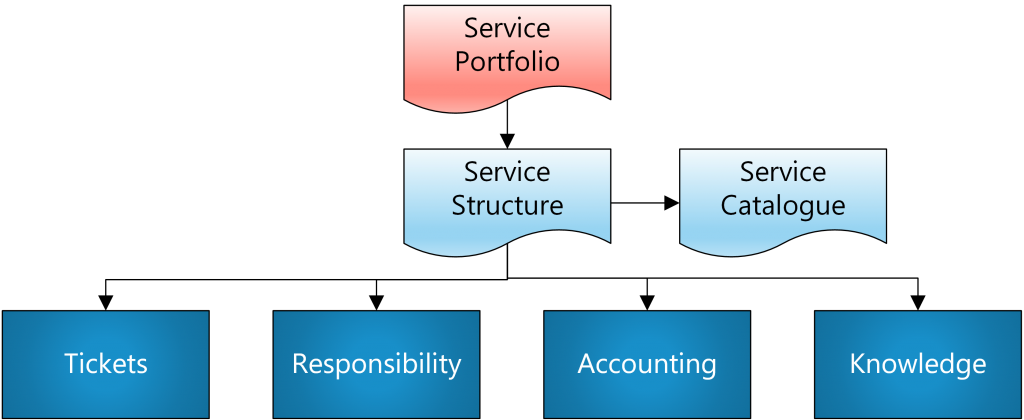
The service portfolio defines the IT organization’s activities and customers at strategic level. This then governs the scope of the service structure. In turn, the IT services are taken from the service structure and presented to the customers in a service catalogue. Categories for ticket management, allocation of responsibilities within the IT organization, economic follow-up and documentation of knowledge are organized in the next step in accordance with the structure that has been developed in the service structure.
The Service Catalogue Management process produces and administers the service structure and the service catalogue.
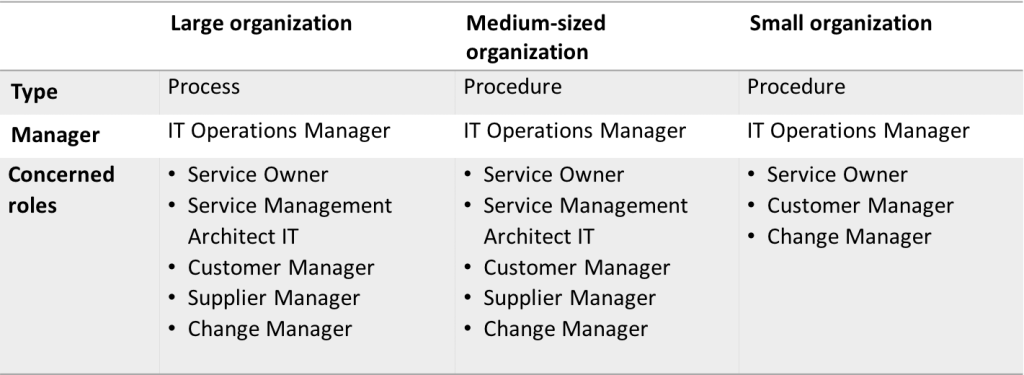
Purpose
The purpose of Service Catalogue Management is to provide a central source with correct information about all IT services that can be ordered from the business and also to administer the service structure which constitutes the basis for other parts within the IT organization.
Achieving the purpose of Service Catalogue Management requires that:
- The service structure is administered and updated on an ongoing basis if the conditions change
- Correctness of information in the service structure is guaranteed
- The service catalogue is available for the business
- The service structure corresponds to the need for information from other processes and functions within the IT organization
Scope
Service Catalogue Management should provide and administer correct information about all services and products used by the IT organization in the delivery of IT to the business.
Service Catalogue Management includes:
- Developing and maintaining templates for documentation of IT services, supporting services and products
- Developing and administering the service structure
- Publishing and administering the service catalogue
- Checking relationships, dependencies and information between the service structure and the service portfolio
- Checking relationships and dependencies between IT services and supporting services
- Checking relationships and dependencies between supporting services and products
Value for the business
Service Catalogue Management enables the business to access correct information about relevant IT services, how it should be used and also which operational process the service is designed to support.
The service catalogue creates:
- A common view of IT services and what they should provide
- Clarity about what the IT organization delivers to the business
- Increased focus on benefit for the business
- Increased efficiency in all processes within the IT organization through a clear and fixed service structure
Terms
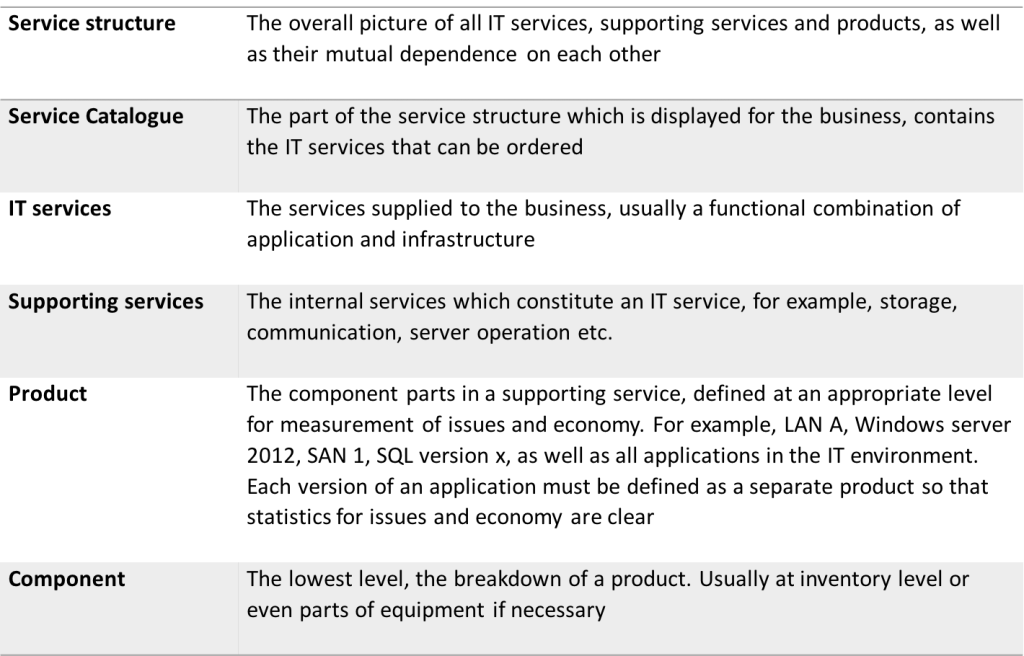
Activities
Service Catalogue Management is an administrative process which requires the service structure and service catalogue to be in place. The activities in the process are therefore concentrated on review and improvement.
The following activities are performed in Service Catalogue Management:
- Review the service structure – Review the service structure and check whether changes need to be implemented.
- Change – If a change in the service structure is necessary, this should be managed via the Change Management process
- Review procedures – Review and update procedures for managing the service catalogue
- Review documents – Review all templates and service descriptions, update if necessary
- Meetings with stakeholders – Convene and hold meetings with all stakeholders in the service catalogue and the service structure in order to obtain proposals for improvements
- Improvements – If necessary, write proposals for improvements for the service catalogue

The Service structure
The service structure is described in the following three levels:
Service catalogue – Descriptions of all services delivered to the business. The service catalogue is for customers and should reflect their interests. At this level it is external efficiency that is in focus, i.e. the business’s needs and how the IT services can meet them.
Technical service catalogue – Details about supporting services that are based on the services delivered to the customers. The technical service catalogue contains all relationships between the customer’s services, supporting services and the products. At this level, it is internal efficiency that is in focus, i.e. quality and effectiveness in the production of the services.
Products – Contains the things that ”can be touched”, i.e. all products that constitute the technical analysts’ and developers’ everyday work in the IT department. Each supporting service is broken down into the products it contains. The aim of the product level is to create conditions to enable incidents, changes and costs to be measured and followed-up, the product level can therefore differ significantly between different organizations depending on the nature of the business. When the service structure is created at product level, the most important question is the level at which I want to be able to measure my supporting service.
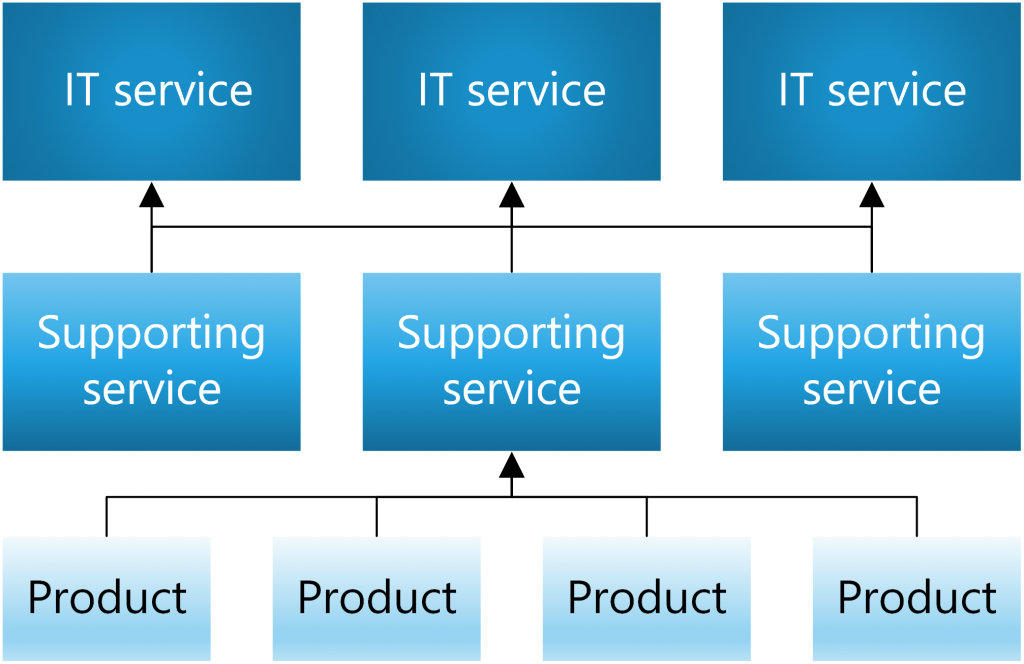
Outsourcing and service structure
When an IT organization outsources all or parts of its IT operation, it is greatly assisted by having developed its service structure and then selecting which supporting services and/or products should be outsourced. This provides a clear connection to who is responsible for which service and also how the outsourcing supplier’s services are linked to its own production of IT services. Even though a service is outsourced, it must be included in the service structure in order to obtain an overall picture of what is delivered to the business and how production fits together. The IT organization is always responsible for IT in relation to the business, and the same goes for outsourced services.
The service catalogue
The service catalogue consists of the IT services at the top level in the service structure. These are sorted into three parts, from where the operations can select which IT services they want to use. The IT services selected are then specified in the agreement (SLA) signed between the IT organization and the business.
Customer-specific services – IT services that are only used by one customer. These services can be special applications used uniquely by one specific business operation. As the IT service is specifically targeted at one operation, there is no reason to display it for all operations, rather it can be sorted under, for example, ”IT services for Accounts”.
Selectable services – IT services which are used by one or several customers and which have a current or future focus to support several different operations. These IT services often have special functionality used by a small number of users dispersed throughout several operations.
Standard services – IT services used by most users in all operations. These IT services are usually packaged together in a standard workplace and are installed regardless of whether the user needs them or not.
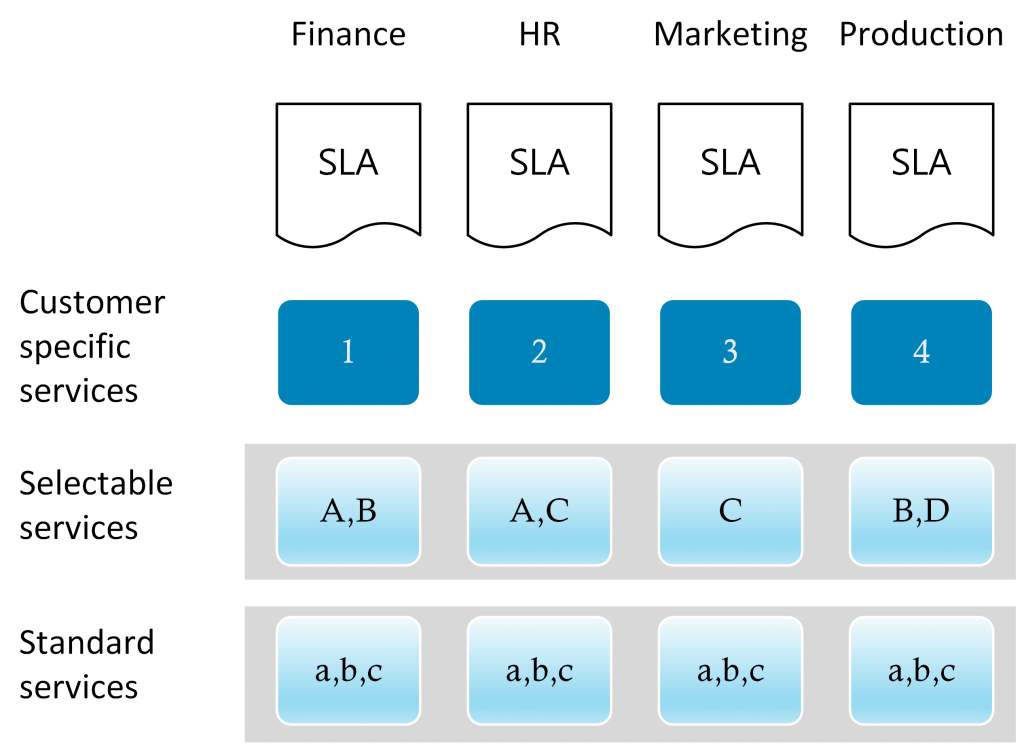
Documentation
The service structure contains a large part of the documentation for the IT services and is an important part of the total documentation.
The following documentation should be available within the framework of Service Catalogue Management:
- The service structure
- The service catalogue
- Service descriptions for IT services
- Description of the service
- Operation/activity which the service is to facilitate
- Ordering alternatives available
- Cost
- Service levels
- Support organization
- Measurement of the service
- Contacts
- Service descriptions for supporting services
- Description of the service
- Service levels
- Measurement of the service
- Products included
- Relationships with other supporting services
- Contacts
- Product specifications
- Description of product
- Availability and capacity
- Daily Operations Management
- Incident Management
- Suppliers and contracts
- Standard changes
- Contacts
Relationships with other processes and functions
Service Catalogue Management has links to many other processes. The most common are listed here:
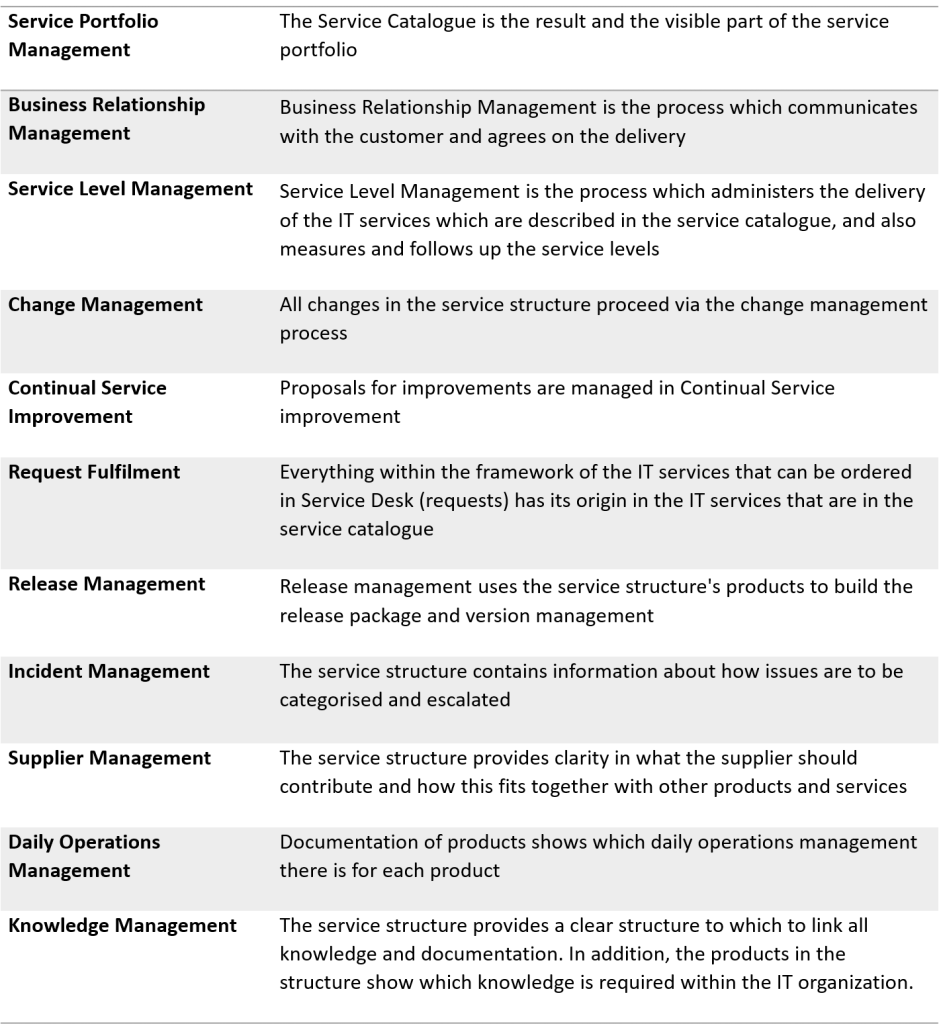
Trigger
As Service Catalogue Management is primarily an administrative process, there is a particular time interval, for example the turn of each month, which is the primary trigger. Besides this, there are also the following triggers:
- Changes in the service portfolio
- Request for change which affects the service catalogue
- Request for change which affects products
- Request for change which affects services
Input
The following inputs are needed for Service Catalogue Management:
- Information about the business (the customer)
- Allocation of responsibilities within the IT organization
- Documentation about the infrastructure and supporting services
- The service portfolio
- Information about how supporting services and service components are linked
- Registered request for change (RFC)
Output
The following outputs are generated in connection with Service Catalogue Management:
- Updates of service catalogue
- Updates of the service structure
- Updates of the service documentation
Measurement
Measurement of Service Catalogue Management can take place through:
- Detecting errors in the service catalogue
- Percentage of the total IT delivery that is defined in the service catalogue
- Number of issues that are received by Service Desk and which cannot be derived from an existing part of the service structure
Challenges
There can be the following challenges in connection with introduction of Service Catalogue Management:
- The service structure which is created affects the entire IT organization. It can be difficult to find a level which suits all stakeholders
- As the service structure must function as an overall structure for the IT organization as a whole, it is important that the structure is approved at the highest level
- Other existing methods used by the IT organization or by the business can make the work of finding a structure more difficult

